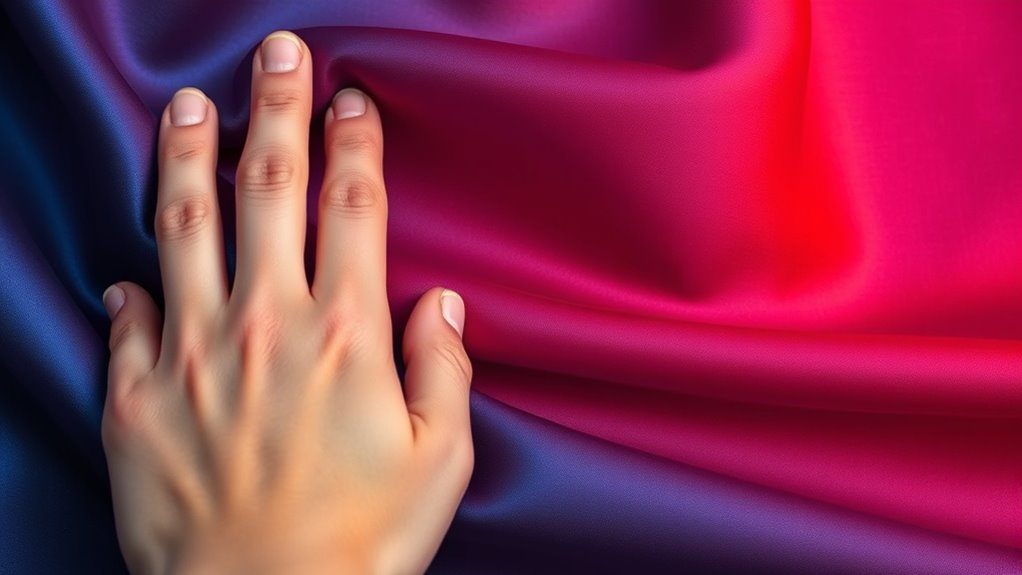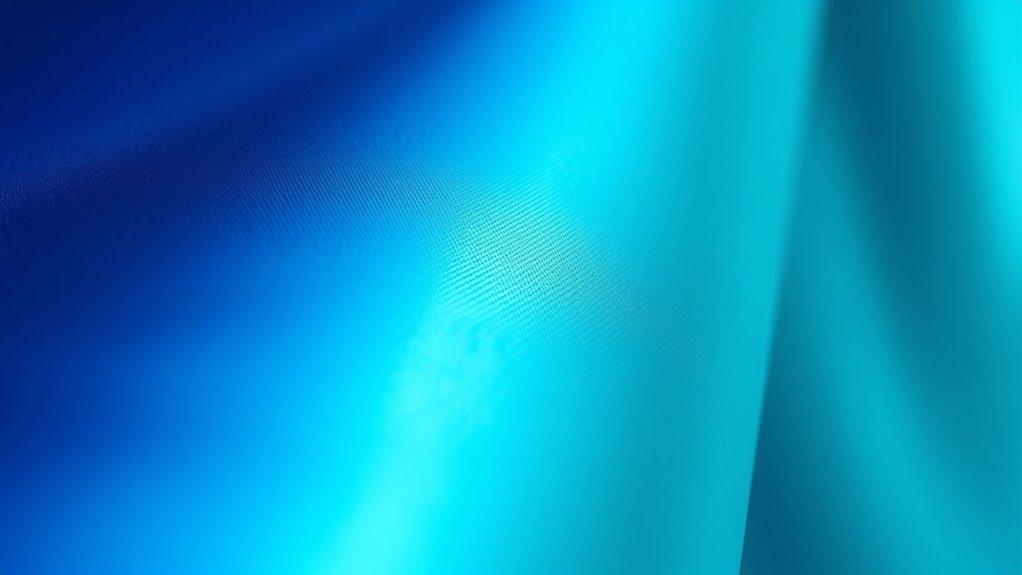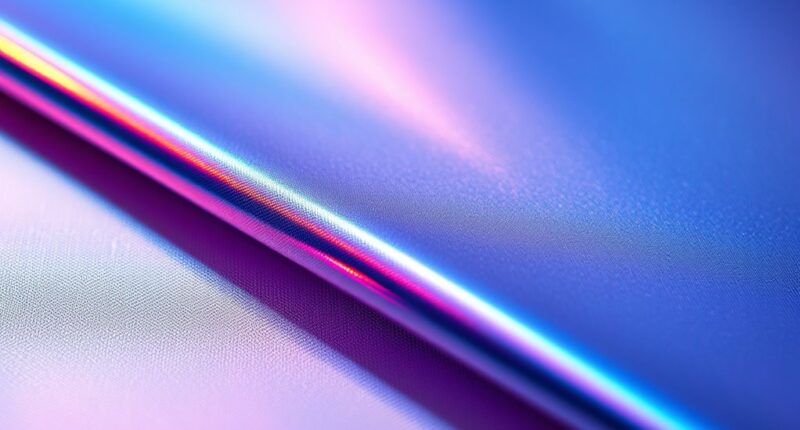Color-changing fabrics respond to stimuli like heat, light, or moisture using special dyes and material technologies. Thermochromic fabrics change color with temperature shifts, while photochromic fabrics react to UV or visible light. Some fabrics use dye diffusion or embedded mechanisms that allow reversible or permanent color shifts. These innovative textiles are crafted carefully into fabric layers, making them durable and efficient. Keep exploring to uncover how these smart materials are revolutionizing fashion and functionality.
Key Takeaways
- Color-changing fabrics utilize responsive dyes and materials that alter their electronic or molecular structure when stimulated by heat, light, or moisture.
- Mechanisms like dye diffusion, fiber modification, or fabric coatings enable dynamic and reversible color shifts in textiles.
- Thermochromic, photochromic, and hydrochromic fabrics respond to temperature, light, or water, creating visual effects based on environmental triggers.
- Durability challenges, such as fiber degradation over time and maintaining performance after washing, limit widespread use of these fabrics.
- Advances in material science and integration with wearable tech are driving innovations for more responsive, sustainable, and user-friendly smart textiles.
Types of Color-Change Mechanisms in Textiles

Have you ever wondered how fabrics change color in response to environmental stimuli? One common mechanism involves dye diffusion, where dyes move within the fiber, creating dynamic color shifts. This process often relies on fiber modification, where the fabric’s fibers are engineered to respond to moisture, light, or other triggers. The dye diffuses through the fiber matrix, resulting in a visible change in color that can be reversible or permanent. Fabric treatments or special coatings can enhance dye diffusion, making the color change more vivid or faster. Fiber modification plays a vital role in these systems, allowing textiles to react efficiently to external cues. Advances in automation technologies have also contributed to the development of more responsive and durable color-changing fabrics. This mechanism is fundamental in creating fabrics that change color based on their environment, offering innovative possibilities for fashion and functionality.
Thermochromic Fabrics and How They Respond to Heat

Thermochromic fabrics change color in response to heat, making them fascinating examples of smart textiles. When you wear these fabrics, they react to your body temperature or external heat sources, creating dynamic visual effects. This heat sensitivity allows for thermal regulation, helping keep you comfortable by adjusting insulation or breathability as needed. Plus, thermochromic fabrics enable fashion personalization, letting you customize your look based on temperature changes or mood. As you interact with the environment, the fabric shifts color, providing an engaging and functional experience. This innovative technology combines style with practicality, making your clothing not just fashionable but also responsive to your body’s needs. Understanding the material composition of thermochromic fabrics helps explain how they can be both durable and responsive. Thermochromic fabrics blend utility and creativity, offering a new level of wearable customization.
Photochromic Materials: Color Shifts With Light Exposure

Building on the idea of fabrics that respond to environmental stimuli, photochromic materials change color when exposed to different lighting conditions. These fabrics use photochromic dyes, which are light-sensitive compounds that react to ultraviolet or visible light. When you step outdoors into sunlight, the dyes undergo a chemical transformation, causing the fabric to shift color. When you move into shade or indoors, the dyes revert to their original hue. This dynamic process creates eye-catching effects without any external intervention. Light-sensitive fabrics with photochromic dyes are popular in fashion and accessories, offering a unique way to express style. Their ability to change color based on lighting makes them a fascinating example of how innovative textile chemistry can enhance everyday wear. Additionally, understanding how personality traits influence consumer preferences can help designers create more appealing and personalized products.
Hydrochromic and Other Environmental-Responsive Textiles

Hydrochromic textiles respond to moisture or water exposure by changing color, offering an innovative way to create interactive garments. This effect relies on dye diffusion within the fabric during fabric dyeing, which makes the color change reversible. When water contacts the textile, it triggers a shift in dye distribution, revealing a different hue. To achieve this, manufacturers carefully select dyes that react to water stimuli and embed them during fabric dyeing. Here are key points:
- The dye diffusion process allows water to alter the fabric’s color temporarily.
- These textiles can be designed to respond to humidity or direct water contact.
- Different environmental-responsive textiles, like thermochromic or photochromic fabrics, expand this concept further.
This technology creates garments that interact with your environment, adding a new dimension to fashion.
The Chemistry Behind Color-Change Dyes and Pigments

Color-changing dyes and pigments achieve their remarkable effects through specific chemical structures that respond to environmental stimuli. In dye chemistry, molecules are designed to alter their shape or electronic states when exposed to temperature, light, or pH changes, resulting in a visible color shift. These dyes often contain reversible bonds or conjugated systems that enable this transformation. Pigment stability is vital because it guarantees the color change remains consistent over time and with repeated use, preventing fading or degradation. The chemistry behind these materials involves balancing reactivity with durability, allowing fabrics to reliably change color without compromising fabric integrity. Understanding dye chemistry and maintaining pigment stability, manufacturers create vibrant, long-lasting color-changing textiles that captivate consumers.
Fabric Construction and Integration of Color-Change Technologies

You’ll see how fabric layering techniques are essential for housing color-change mechanisms securely. By embedding these features within specific layers, the fabrics can respond quickly and reliably. Understanding these construction methods helps you appreciate the seamless integration of advanced technologies into everyday textiles. Incorporating specialized techniques ensures durability and enhances the fabric’s responsiveness to stimuli.
Fabric Layering Techniques
To create fabrics that change color, manufacturers employ advanced layering techniques that combine specific construction methods with integrated color-change technologies. These techniques involve carefully layering different fabric textures to guarantee durability and flexibility while enabling color shifts. You can expect:
- Precise layering of thin, flexible materials that allow light and heat to interact with the embedded color-change agents effectively.
- Strategic placement of reflective or insulating layers to enhance the visual effect during color transitions.
- Combining textured fabrics with smooth surfaces to optimize the visibility of color shifts and maintain comfort.
- Attention to cybersecurity vulnerabilities during manufacturing and integration processes to protect sensitive technology components from potential threats.
Embedded Color-Change Mechanisms
Integrating color-change technologies into fabrics requires precise construction methods that embed reactive agents directly within the textile layers. You achieve this through techniques like dye diffusion, which allows dyes to evenly spread and bond within fibers, and dye fixation, ensuring the color remains stable under various conditions. These mechanisms enable fabrics to change color efficiently in response to stimuli. To deepen understanding, consider this table:
| Technique | Purpose | Effect on Fabric |
|---|---|---|
| Dye diffusion | Distributes reactive agents | Ensures uniform color change |
| Dye fixation | Secures dyes within fibers | Prevents fading and bleeding |
| Layer integration | Embeds mechanisms into textiles | Maintains durability |
Challenges and Limitations of Color-Changing Textiles

Despite their exciting potential, color-changing textiles face several significant challenges and limitations. First, fabric durability can be an issue, as repeated color shifts may weaken the fibers over time, reducing lifespan. Second, the cost implications are considerable; advanced materials and manufacturing processes make these textiles expensive to produce and purchase. Third, maintaining consistent color change performance under various conditions—like washing, friction, or exposure to sunlight—remains difficult. These factors can limit widespread adoption, especially in everyday apparel. While ongoing innovations aim to improve durability and reduce costs, current limitations mean you might need to accept higher prices or shorter lifespans for the novelty and convenience offered by these fabrics. Additionally, some cultural perceptions of fashion trends can influence consumer acceptance and demand.
Future Directions and Innovations in Smart Textile Technologies

Future innovations in smart textiles will likely focus on seamless integration with wearables, making color-changing fabrics more practical and user-friendly. You’ll see advances in sustainable materials that reduce environmental impact while maintaining performance. These developments promise to transform how you interact with and wear color-changing fabrics daily. Additionally, improvements in fiber technology will enhance durability and responsiveness, further elevating the functionality of smart textiles.
Integration With Wearables
As wearable technology advances, researchers are exploring ways to seamlessly combine color-changing fabrics with smart devices, opening new possibilities for customization and functionality. You might see garments that adapt their color based on your mood or environment, thanks to integrated wearable sensors. Here are some exciting developments:
- Enhanced fashion integration, allowing clothing to change color in response to personal style preferences or social settings.
- Real-time feedback from wearable sensors that monitor your health, adjusting fabric color to indicate stress or fatigue.
- Improved connectivity with smartphones or other devices, enabling remote control of fabric color for personalized fashion statements.
- Innovations like Vetted Flat Iron Bike demonstrate the growing trend of integrating advanced technology into everyday items, inspiring similar advancements in smart textiles.
These innovations make smart textiles more intuitive, blending technology with style for a truly interactive experience.
Sustainable Fabric Innovations
Innovations in sustainable fabrics are shaping the future of smart textiles by prioritizing environmental responsibility alongside advanced functionality. You’ll find new techniques like sustainable dyeing, which reduces water use and chemical runoff, making the process less harmful to the planet. Eco-friendly coatings also play a crucial role, providing durability and water resistance without relying on toxic substances. These innovations enable fabrics to maintain performance while minimizing ecological impact. Researchers are exploring bio-based materials and recyclable fibers that can be reused or broken down naturally. Incorporating dog-friendly materials into textile design is also gaining traction, promoting products that are safe for pets and environmentally conscious. By adopting these sustainable practices, you help drive the industry toward greener solutions. These technological advancements ensure that future smart textiles are not only innovative but also aligned with environmental values, paving the way for more responsible fashion and functional products.
Frequently Asked Questions
Are Color-Changing Fabrics Safe for Long-Term Skin Contact?
You’re probably wondering if color-changing fabrics are safe for long-term skin contact. Generally, these fabrics are designed with skin sensitivity and fabric allergy in mind, using non-toxic dyes and materials. However, if you have sensitive skin or a known allergy, it’s wise to check the product details or do a patch test first. Most reputable brands prioritize safety, but staying cautious helps prevent skin irritation over time.
How Durable Are Color Changes After Repeated Washing?
You’ll find that color-changing fabrics are quite wash resistant, but repeated washing can lead to some fabric fading over time. The durability of the color change depends on the quality of the fabric and the washing process. To maintain their vibrant shift, follow care instructions carefully, like using gentle cycles and avoiding harsh detergents. Proper care guarantees your fabrics stay dynamic and colorful longer, even after many washes.
Can These Fabrics Be Customized for Specific Color Patterns?
You can definitely customize color-changing fabrics for specific patterns. Many brands offer options for custom designs, allowing you to create unique looks that suit your style. This pattern versatility means you can incorporate logos, images, or intricate designs into your fabric. Just keep in mind that some customization may require special printing techniques or higher costs, but overall, these fabrics provide great flexibility for personalized, eye-catching apparel.
What Environmental Factors Most Affect the Longevity of Color Change?
Did you know that UV exposure can cause color-changing fabrics to fade faster? You’ll want to pay attention to environmental factors like UV exposure and humidity levels, which considerably impact their longevity. Prolonged sunlight can weaken dye stability, while high humidity accelerates degradation. To keep your fabrics vibrant longer, store them away from direct sunlight and maintain stable humidity levels, ensuring the color change stays sharp and effective over time.
Are There Eco-Friendly Options for Producing Color-Changing Textiles?
You’ll find eco-friendly options for producing color-changing textiles by exploring dye alternatives that are less harmful to the environment. Look for fabrics made through sustainable processes, such as using plant-based dyes or innovative chemical-free methods. These options reduce chemical waste and energy consumption, helping you enjoy the trend responsibly. Choosing such textiles supports eco-conscious fashion and minimizes your ecological footprint while still enjoying the dynamic color effects.
Conclusion
So, don’t worry about these fabrics fading or losing their magic. With ongoing innovations, color-changing textiles are becoming more durable and practical for everyday use. You might think they’re just a trend, but they’re actually shaping the future of smart clothing and functional design. Embrace the possibilities—these fabrics aren’t just cool, they’re a glimpse into how tech and fashion will blend even more seamlessly.









